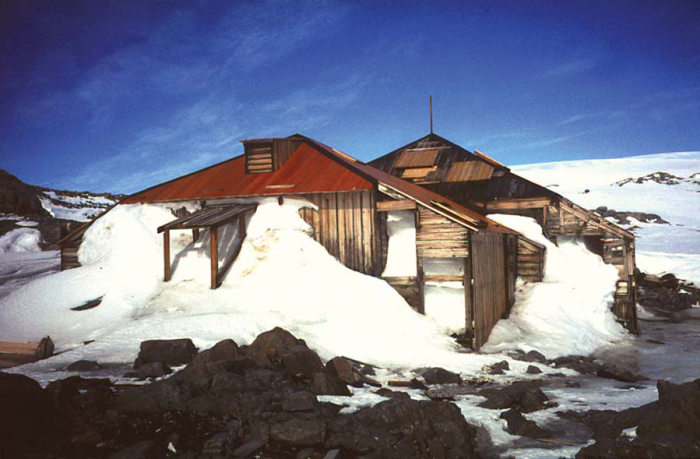




オーストラリアの歴史的過去の象徴であるモーソンズ ハットは、1911 年から 1914 年にかけてのオーストラリア南極探検隊に関連する 4 つの歴史的な小屋構造物とその他の遺物のうちの 1 つです。モーソンズ ハットは、南極探検の英雄時代と呼ばれる時代に建てられた、オーストラリア唯一の例であり、現存する 6 つの国際的な複合施設の 1 つとして、国際的および国内的に重要な意味を持っています。
モーソンズ ハットがあるケープ デニソンは、海面では地球上で最も風が強い場所として知られています。平均して、1 日の最大風速は 44 mph で、気温は 0°C から -20°C の範囲です。この場所は、メイン ハット、マグネトグラフ ハウス、トランジット ハット、アブソリュート マグネティック ハットの 4 つの建物で構成されています。メイン ハットとマグネトグラフ ハウスは、100 年という歳月をかなりうまく乗り越えてきました。トランジット ハットとアブソリュート マグネティック ハットは、「現存する廃墟」として保存するために安定化されています。
モーソンズ ハットの保護に向けた最初の動きは、1970 年代後半にオーストラリア政府南極局によって行われました。2 度目の保護活動であるプロジェクト ブリザードは、1984 年から 1986 年にかけて行われました。これらの活動は熱意に欠けるものではありませんでしたが、その取り組みを導く正式な保護計画はほとんどありませんでした。
1990 年代までに、モーソンズ ハットの状態に対する一般の関心が高まりました。この場所の最初の保存計画は 1993 年に策定されました。1996 年から 1997 年にかけて行われた現地調査で、矛盾が明らかになりました。環境条件がモーソンズ ハットの保存要因であると同時に破壊要因でもあったのです。極寒のため、通常の有機木材の脅威は生き残ることが困難であり、猛烈な風によって吹き飛ばされた雪や氷の粒子が木材の外装を摩耗させ、小屋の屋根はほぼ壊れかけていました。1997 年から 1998 年にかけて行われた修復には、壊れた内部の木材構造の修理と屋根の一部の外装の張り替えが含まれていました。これにより、モーソンズ ハットは差し迫った危険からは救われましたが、1993 年の保存計画の範囲外であった積雪と氷の除去という長期的な問題は解決されませんでした。
1996 年にオーストラリア通信社の支援を受けて設立された AAP モーソンズ ハッツ財団は、保全活動をさらに推し進めることを決意しました。1998 年後半に開催されたセミナーでは、さまざまな関係者の見解が発表されました。セミナーの成果として、1998 年から 1999 年の夏にかけて実施された監視プログラムが生まれました。特に懸念されたのは、小屋内の氷の除去が、木材、織物、文書、機械、金物、食品、化学薬品など、膨大な数の歴史的遺物に与える影響でした。その後の保全管理計画では、影響評価プロセスに従って氷を除去するという目標が設定されました。この評価では、相対湿度の許容変動など、一連の意思決定基準と閾値が策定されました。
オーストラリア博物館の材料および建築環境研究センターの Vinod Daniel 氏は、1998 年に CSA に連絡を取り、モーソンズ ハットのさまざまな環境パラメータを監視するシステムの設計を依頼しました。1999 年 1 月、システムは 2000 年 1 月まで稼働させる目的で設置されました。バッテリーの問題を除けば、システムは研究期間中、完璧に動作しました。
プロジェクト中に収集されたデータから、日々の温度と湿度のサイクルは、夏季の太陽放射が著しい場合にのみ発生することが実証されました。内部の温度サイクルは外部より数時間遅れており、それほど極端ではないことから、現在の建物の状態では断熱効果が得られることがわかります。また、小屋内の湿度が常に高いため、低温にもかかわらず内部の木材に十分な湿気が生じ、生物による劣化が起こることも判明しました。
モーソンズ ハットの監視システムは 2000 年 1 月以来使用されていませんが、現在、2002 年にプロジェクトを再開するための資金が求められています。
このような極端な環境条件下でも、Campbell Scientificの製品は、保全前の計画や、保全処理の成功を判断するためのプロジェクト後のデータ分析に不可欠なツールであることが証明されています。
計器類
2 MB の拡張メモリを備えた 1 台の CR10X データロガーで、史跡の測定と制御を行いました。データロガーは、8 台の HMP45C 気温および RH センサー、16 台の熱電対 (AM25T 熱電対マルチプレクサ経由)、および太陽放射センサーを測定しました。
データは PCMCIA カードに保存され、定期的に PC にダウンロードされ、その後、インマルサット Mini-M 衛星電話を介してオーストラリアに送り返されました。このプロジェクトで最も困難な設計上の問題は、現場で予想される -40ºC の気温に対する特別な配慮でした。機器の電源には、Siomar バッテリーの塩化チオニルリチウム電池が選ばれました。HMP45C は、測定前に 1 分間のウォームアップ期間が与えられ、CR10X のプログラミングでは、システムの電力要件を最小限に抑えるためにいくつかの手順が踏まれました。
謝辞: CSA は、この文書で使用した資料を提供してくれたオーストラリア博物館の Vinod Daniel 氏、CSIRO の Wayne Ganther 氏、Godden Mackay Logan の Geoff Ashley 氏、ニューサウスウェールズ州立図書館の Steve Martin 氏に感謝の意を表します。